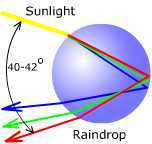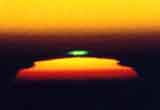THE NATURAL ENVIRONMENT
Geography 101
ToC
SKY
Origin
Air
Layers
Sunlight
Scatter
Refract
Hawai'i
Refraction
Another colorful optical process is refraction, which simply means bending of the light beam in a geometrically predictable way. This happens when sunlight encounters the surface of any medium it can travel through, such as glass, air, or water. The angle through which the solar beam bends depends on wavelength, with the shortest wavelengths bending through the greatest angle. Thus, refraction separates the solar beam into its component wavelengths, which we see as colors.
|
|
BOX 1 |
 The best-known refraction phenomenon is the rainbow. When sunlight
strikes cloud and rain drops at an exact angle to the drop
surface, the beam bends once (separating colors) and reflects off of
the inside back of the drop. When it exits, the light is bent again,
further separating the colors. Blue light bends through the greatest
angle and red light the least. This means that red comes toward
your eye from higher in the sky and thus forms the
outside color of the rainbow, as you can see by the image below.
Double rainbows have a double
reflection inside the drop and thus the colors in the second arc are
reversed.
The best-known refraction phenomenon is the rainbow. When sunlight
strikes cloud and rain drops at an exact angle to the drop
surface, the beam bends once (separating colors) and reflects off of
the inside back of the drop. When it exits, the light is bent again,
further separating the colors. Blue light bends through the greatest
angle and red light the least. This means that red comes toward
your eye from higher in the sky and thus forms the
outside color of the rainbow, as you can see by the image below.
Double rainbows have a double
reflection inside the drop and thus the colors in the second arc are
reversed.
When you see a rainbow, the sun is always directly behind you with your shadow pointing toward the center of the full arc. Partial arcs may form when rain covers only a portion of the sky.

 Refraction combined with scattering provides another interesting and highly elusive,
optical phenomenon: the green flash. Yes, it exists
as you can see in the image. When the sun is low on the horizon, refraction separates the colors in sunlight.
Because shorter wavelengths bend through the greatest angle,
green comes to your eye from a slightly higher position in the sky than
red. For an instant at sunset, the blue has been scattered out, the
horizon
blocks the red light, and green wavelengths dominate the remaining direct solar beam.
Refraction combined with scattering provides another interesting and highly elusive,
optical phenomenon: the green flash. Yes, it exists
as you can see in the image. When the sun is low on the horizon, refraction separates the colors in sunlight.
Because shorter wavelengths bend through the greatest angle,
green comes to your eye from a slightly higher position in the sky than
red. For an instant at sunset, the blue has been scattered out, the
horizon
blocks the red light, and green wavelengths dominate the remaining direct solar beam.
To see it, you need clear sky conditions and a clear, flat horizon. In Honolulu, Magic Island is a favorite spot for green flash watching, especially in winter when the sun sets more to the south. Here's a rule of thumb: If you see it, you'll know. If you aren't sure whether you saw it or not, you didn't.